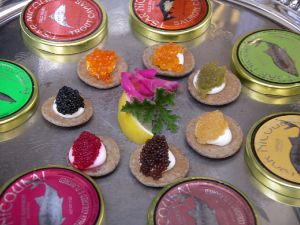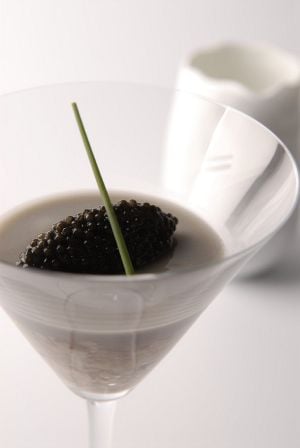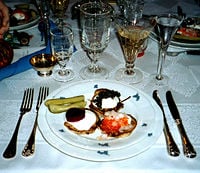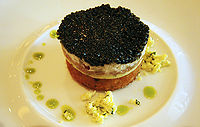Caviar
Caviar is the processed, salted roe of certain species of fish, most notably the sturgeon. It is commercially marketed worldwide as a delicacy and is eaten as a garnish or a spread; for example, with hors d'œuvres.
Preparation
History
The word caviar entered English via Italian [1] or Turkish,[2]; it is ultimately derived from Persian khaviyar, from khaya "egg" (from Middle Persian khayak "egg," from Old Iranian *qvyaka-, diminutive of *avya-, from PIE *owyo-/*oyyo- "egg") + dar "bearing." [3]
Some also think it derives from the Persian word خاگآور (Xâg-âvar), meaning "the roe-generator"; others say chav-jar, which means "cake of power," a reference to the ancient Persian practice of eating caviar in stick form as a kind of elixir.[4]
In Persian, the word refers to both the sturgeon and its roe; in Russian, the word икра (ikra), "roe," is used. The Russian word malossol ("little salt") sometimes appears on caviar tins to show that the caviar is minimally salted; typically, caviar is 4% to 8% salt, with the better-brand varieties generally being less salted.
Use
Cultural significance
Given its high price in the West, caviar is synonymous with luxury and wealth. In Russia and other Eastern European cultures, though still expensive, caviar is commonly served at holiday feasts, weddings, and other festive occasions. Sturgeon-derived caviar is generally not eaten by Jews who keep kosher, because sturgeon lacks scales and thus is not considered kosher; however, this does not apply to every roe-yielding fish species. In Islam all sea or river animals such as fish are lawful and halal which applies to the sturgeon as well as its caviar (depending on which school of practice). In Hong Kong and Japan, caviar may be found on sushi and is often very affordable.
Issues
In the early 1900s, Canada and the United States were the major caviar suppliers to Europe; they harvested roe from the lake sturgeon in the North American midwest, and from the Shortnose sturgeon and the Atlantic sturgeon spawning in the rivers of the Eastern coast of the United States. Today, however, the Shortnose sturgeon is rated Vulnerable in the IUCN Red List of endangered species and rated Endangered per the U.S. Endangered Species Act.
In Spain a fish farm called Caviar de Riofrio has begun to produce organic caviar. The company raises sturgeon in such a way that it has earned organic certification by CITES.[5]
Current aquaculture of sturgeon is an economically viable means of sustainable, commercial caviar production, especially in Spain, France, Uruguay, and California.[6] Hackleback caviar is a popular, inexpensive product of this industry. Paddlefish, a sturgeon cousin, is also farmed in increasing numbers.
Recently, the amount of allowed wild fish harvesting has been decreased, consequently increasing caviar prices. In September 2005, the United States Fish and Wildlife Service banned the import of Caspian Sea Beluga caviar, to protect the endangered Beluga sturgeon; a month later, the ban included Beluga caviar from the entire Black Sea basin. In January 2006, CITES, the convention for trade in endangered species, announced they were "unable to approve the [caviar] export quotas" for 2006 from wild fish stocks.[7] In January 2007, this ban was partly lifted, allowing the sale of 96 tons of caviar, 15% below the official 2005 level.[8]
Varieties
The Caspian Sea is considered the source of the finest caviar in the world. Contemporary black caviar is roe from sturgeon fished from the Caspian Sea by Azerbaijan, Iran, Russia and Kazakhstan. The highest prices paid are for the Beluga, Ossetra, and Sevruga varieties. (The large-grained Beluga caviar is from the Beluga sturgeon, a fish which is unrelated to the Beluga whale, a mammal.) The golden Sterlet caviar was once a favorite of czars, shahs, and emperors. Currently, the dwindling fishing yields consequent to overfishing and pollution have resulted in the creation of less costly, though popular, caviar-quality roe alternatives from the whitefish and the North Atlantic salmon.
The harvest and sale of black caviar was banned in Russia since August 1, 2007. The ban extends for ten years, but scientific research and the artificial breeding of black caviar fish are exempted.
Alternatives and imitation
In Scandinavia, a significantly cheaper version of caviar, made from mashed and smoked cod roe, is sold in tubes as a sandwich filling. When sold outside Scandinavia, in stores such as IKEA's Swedish food market, the product is referred to as creamed smoked roe.
An obvious sturgeon caviar imitation is Danish black coloured lumpsucker caviar, which is sold throughout Europe in small glass jars. It can also be found red coloured. A more expensive sturgeon caviar alternative, sold in Sweden and Finland, is the caviar from the vendace. In Finland caviars from the burbot and the common whitefish are also sold.
In the vegetarian foodstuffs market, Algae-based imitation caviar is produced and sold as a caviar alternative.
Notes
- ↑ http://www.etymonline.com/index.php?term=caviar
- ↑ Merriam-Webster Online: Caviar. Merriam-Webster. Retrieved 2007-11-25.
- ↑ http://www.etymonline.com/index.php?term=caviar
- ↑ LEDA at Harvard Law School - A Brief History of Caviar
- ↑ www.boston.com - More than one fish egg in the sea
- ↑ California Farm Bureau Federation - Farmers tame prehistoric fish to make food fit for a king
- ↑ news.bbc.co.uk - International caviar trade banned
- ↑ news.bbc.co.uk - UN lifts embargo on caviar trade
ReferencesISBN links support NWE through referral fees
- Boeckmann, Susie, and Natalie Rebeiz-Nielsen. Caviar: The Definitive Guide. Wiley, 2000. ISBN 978-0470392997
- Carey, Richard Adams. The Philosopher Fish: Sturgeon, Caviar, and the Geography of Desire. Counterpoint, 2006. ISBN 978-1582433523
- Inman, Mason. Once Endangered Sturgeon Rebounding in Hudson River, Study Says National Geographic News, February 7, 2007. Retrieved July 3, 2008.
- Javadi, Masoud, and Nasser Sagheb Caspian caviar in peril Azerbaijan International 2.3 (Autumn 1994): 50-52. Retrieved July 3, 2008.
- Le Goff, Olivier. The World of Caviar. Chartwell Books, 1999. ISBN 978-0785810841
- Morris, Jim. Dinosaur in the Delta: Farmers tame prehistoric fish to make food fit for a king California Farm Bureau Federation, August 3, 2005. Retrieved July 3, 2008.
- Saffron, Inga. Caviar: The Strange History and Uncertain Future of the World's Most Coveted Delicacy. New York, NY: Broadway Books, 2003. ISBN 978-0767906241
- Swengel, Andrea Lynn. Discovering Caviar . Campbell & Lewis Publishers, 2008. ISBN 978-0977148974
External links
- Caviar Cooking For Engineers
- American Caviar - Think American Caviar!
- History Russian Caviar, 2000.
Credits
New World Encyclopedia writers and editors rewrote and completed the Wikipedia article in accordance with New World Encyclopedia standards. This article abides by terms of the Creative Commons CC-by-sa 3.0 License (CC-by-sa), which may be used and disseminated with proper attribution. Credit is due under the terms of this license that can reference both the New World Encyclopedia contributors and the selfless volunteer contributors of the Wikimedia Foundation. To cite this article click here for a list of acceptable citing formats.The history of earlier contributions by wikipedians is accessible to researchers here:
The history of this article since it was imported to New World Encyclopedia:
Note: Some restrictions may apply to use of individual images which are separately licensed.





